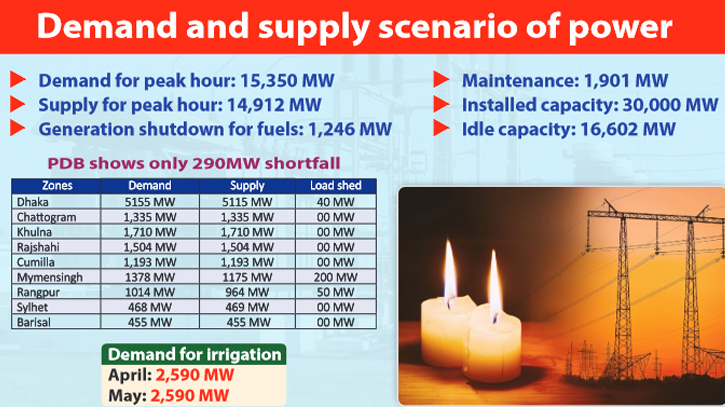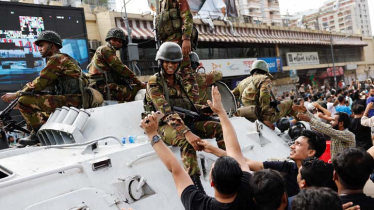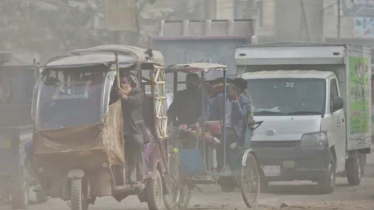
Photo: Messenger
The demand for electricity has surged with the resumption of production in all industries after Eid, yet electricity production has not kept pace. Consequently, load shedding has intensified, compounding the discomfort in the sweltering heat. While load shedding is less frequent in urban areas, such as the capital Dhaka, it is worsening in rural areas, exacerbated by the ongoing heatwave.
The correspondents of the Daily Messenger have reported that Rangpur, Dinajpur, Savar, Noakhali, Sylhet, Chuadanga, Gaibandha, Jhenaidah, Rajshahi, Sylhet, and other areas of the country are experiencing load shedding for five to six hours.
Correspondent Debobroto Gosh from Sylhet reported that the region is experiencing five to six hours of load shedding, while Anissujaman from Rajshahi informed that they are facing four to five hours of load shedding, and Mazharul Mannan from Rangpur reported suffering from seven to eight hours of load shedding.
However, the country is facing severe load shedding as 1,901 MW of power plants are out of operation for maintenance and 1,246 MW due to fuel shortages, causing load shedding.
Surprisingly, the Power Development Board (PDB) reported only 374 MW, and the Power Grid Company reported 418 MW of load shedding on Sunday, while generation was recorded at 14,912 MW against the demand of 15,350 MW at 5pm, the peak hour. Though the government earlier projected a demand of 17,800 MW for the summer.
Although officials have claimed they are prepared to supply power according to demand and have an adequate amount of fuels.
AKM Gause Mohiuddin Ahmed, Managing Director of PGCB, told the Daily Messenger, “We are prepared to meet the demand. All things depend on fuel supply. Already, gas supply has been increased, and we are prepared for the summer. I think demand will increase to 17,000 MW next week.”
Generally, the government supplies power smoothly to the capital city, Dhaka, utilizing every effort, while urban areas of the country have been facing load shedding for six to eight hours at regular intervals for years.
“In fact, the country is facing a severe dollar crisis, which is why we cannot even import when the prices of coal and LNG decrease in the international market. Mainly, the dependency on imported fuel has made the crisis more serious,” prominent energy expert Professor Izaz Hossain told the Daily Messenger.
The Advisor of the Consumer Association, Professor Shamsul Alam, said, “The government's desperate attempt based on imported fuel has created such kind of uncertainty. We should go slow in power generation. The government has stopped exploring domestic gas, which may keep the fuel crisis of the county.”
According to the PDB, the use of various types of fans, including AC, has increased to alleviate the heat throughout the country, including the capital. Additionally, the demand for electricity has surged as production has resumed in all industries after the Eid holidays. Demand across the country has exceeded 15,000 MW. Load shedding was recorded at 500 MW. The electricity demand was 13,380 MW, 13,325 MW. The demand may increase by 1,000 to 1,500 MW during the evening peak hours.
According to the Power Grid Company of Bangladesh (PGCB), load shedding had to be implemented all day last Thursday due to power shortages. The maximum load shedding of 684 MW had to be implemented at 1 pm last Thursday when the demand was lower than on Sunday.
The distribution companies outside Dhaka report that electricity is being supplied at 20-50 percent less than the demand in different areas. If the supply does not increase, load shedding will further increase.
Rural Electrification Board (REB) sources said that they are not receiving power supply as per the demand. Therefore, there is a shortfall in distribution.
The Chattogram bureau chief of The Daily Messenger, SM Akash, said that load shedding has increased in Chattogram due to intense heat. But according to PDB, power generation has increased compared to before. So, there is no load shedding in Chattogram.
However, consumers said the pain of load shedding has not eased. Although the situation has improved somewhat, electricity is still intermittent. Suffering from load shedding has increased during intense heatwaves.
The government had undertaken mega projects to meet the power demand of the 100 economic zones. Gradually, the EZs are getting ready for industrialization, but a major portion of the power generation capacity cannot generate power due to fuel scarcity.
However, the highest generation in the country is 16,660 MW against a capacity of 24,000 MW, with 44 percent of the capacity sitting idle.
According to Vision 2041, the government is working to implement a power generation capacity of 40,000 MW by 2030 and 60,000 MW by 2041, as per the Power System Master Plan (PSMP).
Messenger/Disha








